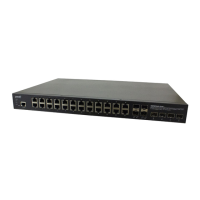Lantronix SISPM1040-xxxx-L3 Web User Guide
33856 Rev. A https://www.lantronix.com/ 298
SF MEP: The Domain::Service::MEPID (e.g., Dom3::Svc3::2) refers to a MEP instance which shall represent the
Working flow. Only used when SF Trigger is MEP. The selected MEP instance does not need to exist when this
APS is configured.
Mode: At the dropdown select 1:1, 1+1 Uni, or 1+1 Bi:
1:1 : This will create a 1:1 APS. In the linear 1:1 protection switching architecture, the protection transport
entity is dedicated to the working transport entity. However, the normal traffic is transported either on the
working transport entity or on the protection transport entity using a selector bridge at the source of the
protected domain. The selector at the sink of the protected domain selects the entity which carries the
normal traffic.
1+1 Uni : This will create a 1+1 Unidirectional APS.
1+1 Bi : This will create a 1+1 Bidirectional APS.
In linear 1+1 protection switching architecture, a protection transport entity is dedicated to each working transport
entity. Normal traffic is copied and fed to both working and protection transport entities with a permanent bridge at
the source of the protected domain. The traffic on working and protection transport entities is transmitted
simultaneously to the sink of the protected domain, where a selection between the working and protection
transport entities is made based on some predetermined criteria, such as server defect indication.
Level: MD/MEG Level (0-7).
VLAN: The VLAN ID used in the L-APS PDUs. 0 means untagged.
PCP: PCP (priority) (default 7). The PCP value used in the VLAN tag unless the L-APS PDU is untagged. Must be
a value in range 0 - 7.
SMAC: Source MAC address used in L-APS PDUs. Must be a unicast address. If all-zeros, the switch port's MAC
address will be used.
Rev: When checked ( ) the port recovery mode is revertive, that is, traffic switches back to the working port
after the condition(s) causing a switch has cleared. In the case of clearing a command (e.g., forced switch), this
happens immediately. In the case of clearing of a defect, this generally happens after the expiry of the WTR
(Wait-To-Restore) timer.
When unchecked ( ) the port recovery mode is non-revertive and traffic is allowed to remain on the protect port
after a switch reason has cleared.
TxAps: Choose whether this end transmits APS PDUs. Only used for 1+1 Unidirectional (1+1 Uni.
WTR: When Rev is checked, WTR (Wait-To-Restore) tells how many seconds to wait before restoring to the
working port after a fault condition has cleared. Valid range 1 - 720
HoldOff: When a new (or more severe) defect occurs, the hold-off timer will be started, and the event will be
reported after the timer expires. HoldOff time is measured in milliseconds, and valid values are 0 - 10000.
The default is 0, which means immediate reporting of the defect.
Enable: The administrative state of this APS instance. Check to make it function normally and uncheck to make it
cease functioning.
Oper: This field cannot be configured but it shows the operational state. You can click on the link in the APS #
field to get more details on the status.
(up) : The APS instance is functional.
(down) : The APS instance is not functional.
Warning: If the operational state is Active, the APS instance is indeed active, but it may be that it doesn't run as
the administrator thinks, because of configuration errors, which are reflected in the warnings below.
The Warning information is indicated by
: no warning or : warning.
Use the tooltip to get detailed warning information (e.g., “No warnings. If operational state is Active, everything is
fine” or “Working MEP is not found. Using link-state for SF instead”).

